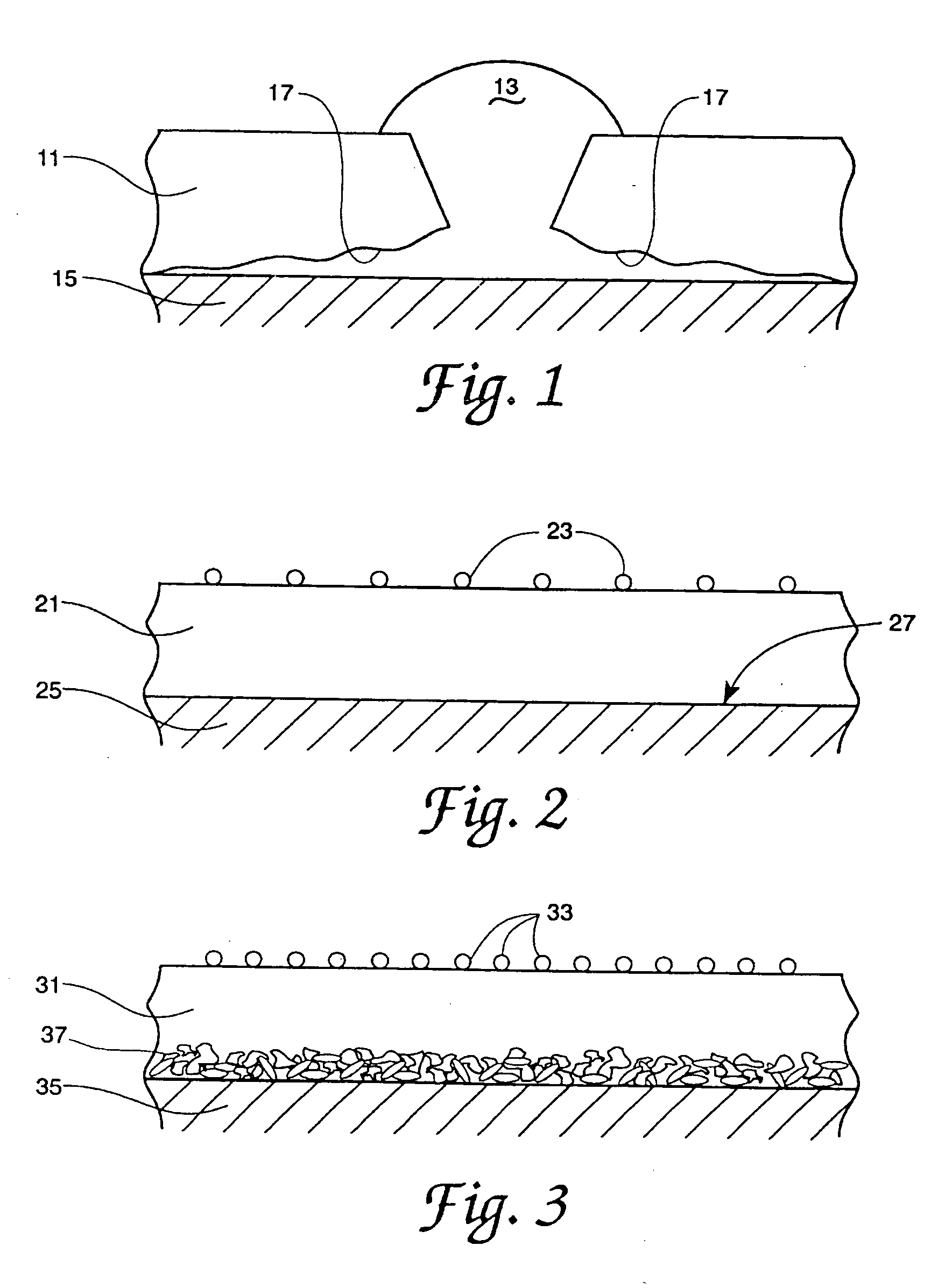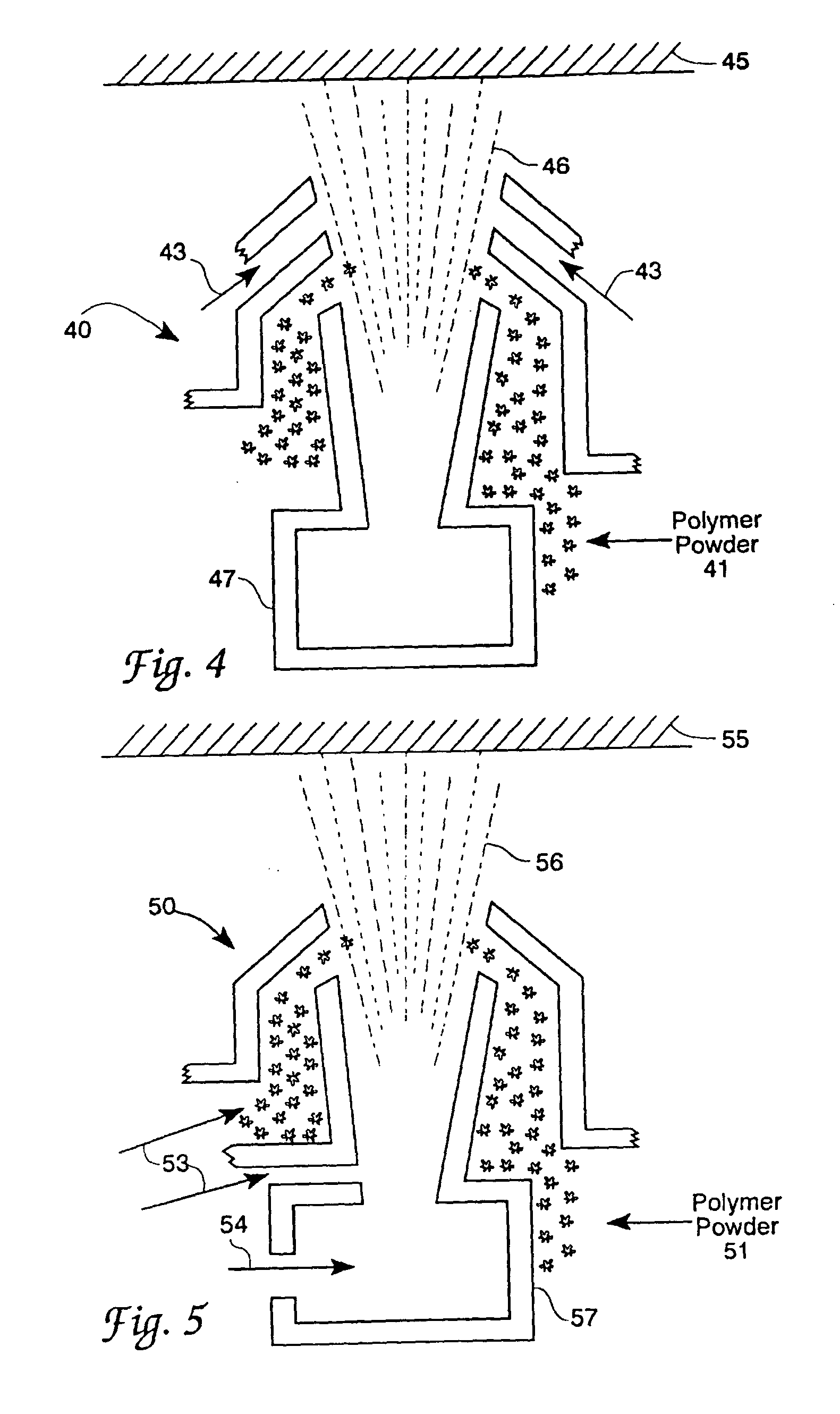Process for coating substrates with polymeric compositions
a technology of polymeric compositions and substrates, applied in the field of steel containers, metallic and nonmetallic substrates, to achieve the effects of low permeability, elimination of voids, and elimination of free volume voids
- Summary
- Abstract
- Description
- Claims
- Application Information
AI Technical Summary
Benefits of technology
Problems solved by technology
Method used
Image
Examples
example 1
PVF2 Polymeric Coatings
One of the most preferred polymers is PVF2 (Polyvinylidene Fluoride). Ground to 20 to 100 microns with an average of 50 microns the powder provides a very good thermoplastic for the HVIF System. The thermoplastic HVIF applied powder provides a corrosion resistant, protective weld overlay to HDPE or EVOH plastic fuel tank substrates from 0.015 to 0.060 inches in thickness sprayed over pinch areas and seams. The PVF2 provides weld overlay film impermeable to hydrocarbon, alcohols and fuel vapor permeation, and a wide variety of corrosive environments up to 300° F. and in addition has excellent mechanical properties, such as impact resistance.
The usage temperature range for spraying PVF2 over HDPE substrate is from a negative −60° C. (−76° F.) to 170° (338° F.). The HVIF gun process provides a circumferential array of shielding (inert nitrogen gas) during spraying operations that suppresses crystallization in the fusion zone. The layers are predominately amor...
example 2
Nylon 12 Polyamide Block
Prepared round particles of nylon-12, air classified and screened to 20 to 80 microns with overall average 50 micron size, provide excellent melt flow (coating behaves like liquid). The melting point of 176 degrees C. enables a favorable processing temperature. Nylon-12 can be used at temperatures considerably less than 0° C. without alteration in properties. Nylon-12 is stable on long term exposure to heat of up to +80° C. and for brief periods can be further heated with damage. In a mechanically unstressed state, Nylon-12 tolerates temperatures up to 160° C. HVIF Thermospray System application of Nylon-12 over pinch areas of plastic fuel tanks provided the following advantages: 1. Impermeability to hydrocarbon and fuel vapors; 2. Adds strength to weak, vulnerable seam pinch areas (crash resistance); 3. Higher performance; 4. Excellent resistance to adverse road sites, debris, abrasion and erosion; and 5. Provides a fusion zone of chemical bonding to ...
example 3
Dupont Abcite X 60 X70-Natural Product Code B PC7900 S8000
The X60 processes very well. A chemical bonding between the EVOH and HDPE composite multilayers is seen under electron microscopy. Analysis reveals a blending or mixing dilution zone that is very pronounced. The X60 and X70 must be stored in a dehumidifier room as they pick up moisture and clump. When powder is stored in powder feed canister for a short period of time the cold liquid nitrogen gas dries up the powder and it processes well. Mica and or Silica platelets blended into the Abcite provide an additional protection barrier against hydrocarbon and fuel permeation. The Abcite X60 is very flexible and protects flexibility of the pinch area even when a water filled fuel tank is dropped from 20 ft. high. No cracks or leaks were noted. X60 is a good material as a bonding overlay film, especially when combined with a second layer of Nylon-12 that provides a good barrier against hydrocarbon permeation.
Parameter Developmen...
PUM
| Property | Measurement | Unit |
|---|---|---|
| Fraction | aaaaa | aaaaa |
| Fraction | aaaaa | aaaaa |
| Percent by mass | aaaaa | aaaaa |
Abstract
Description
Claims
Application Information
 Login to View More
Login to View More - R&D
- Intellectual Property
- Life Sciences
- Materials
- Tech Scout
- Unparalleled Data Quality
- Higher Quality Content
- 60% Fewer Hallucinations
Browse by: Latest US Patents, China's latest patents, Technical Efficacy Thesaurus, Application Domain, Technology Topic, Popular Technical Reports.
© 2025 PatSnap. All rights reserved.Legal|Privacy policy|Modern Slavery Act Transparency Statement|Sitemap|About US| Contact US: help@patsnap.com


